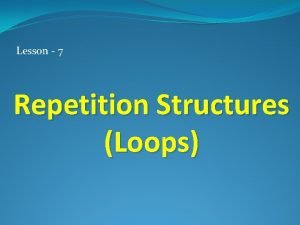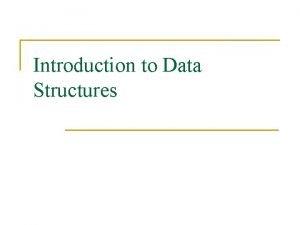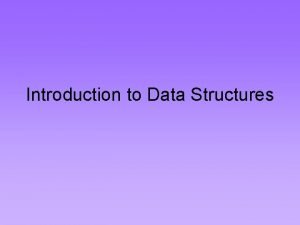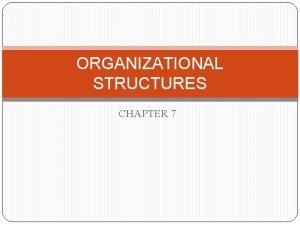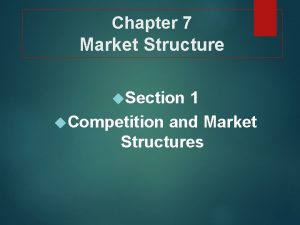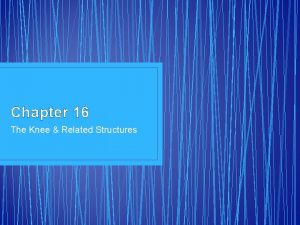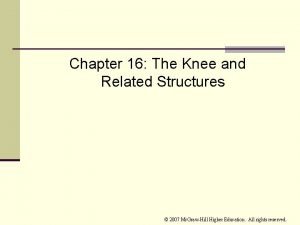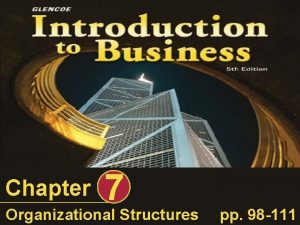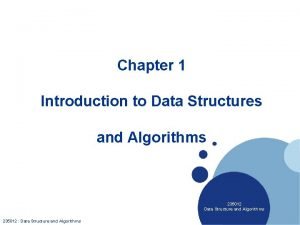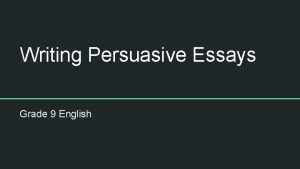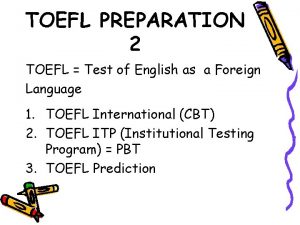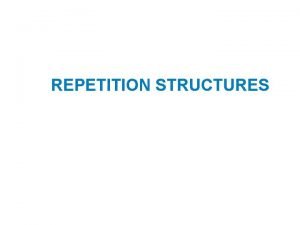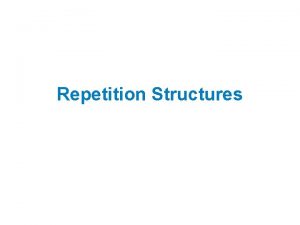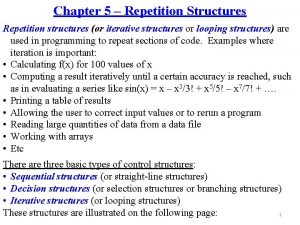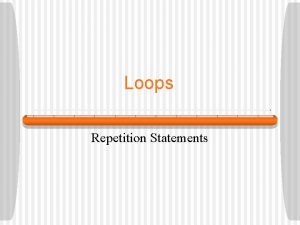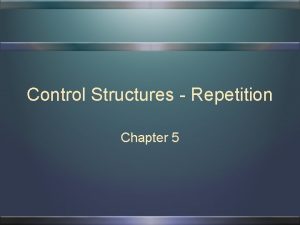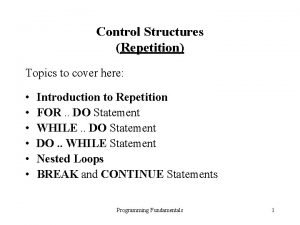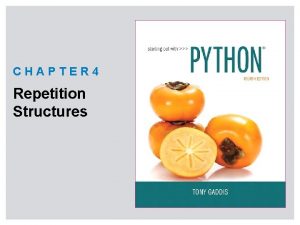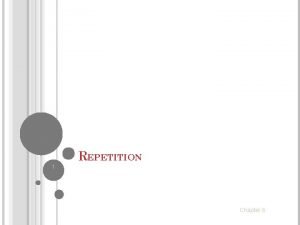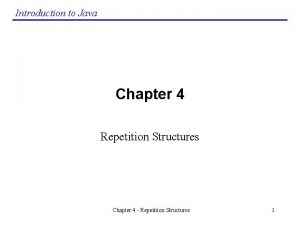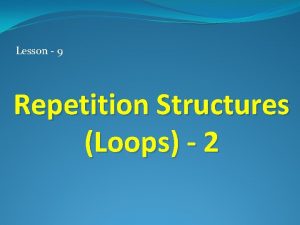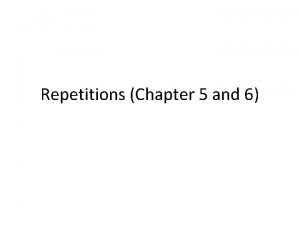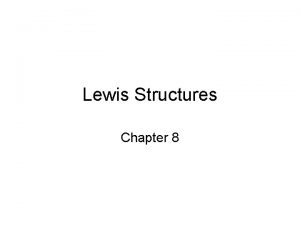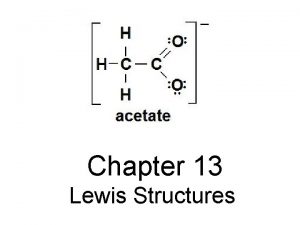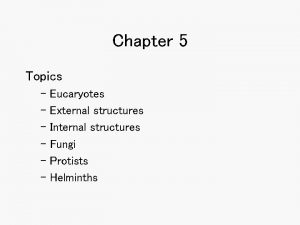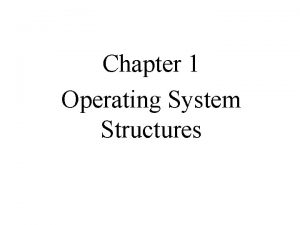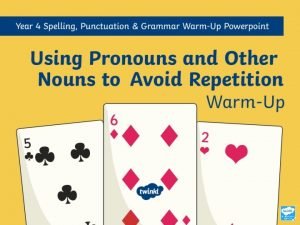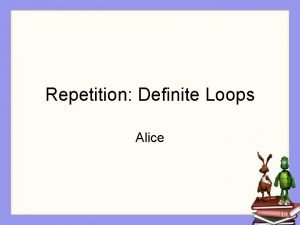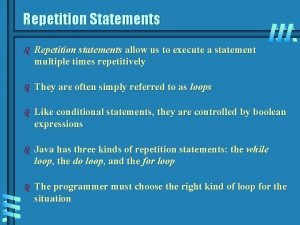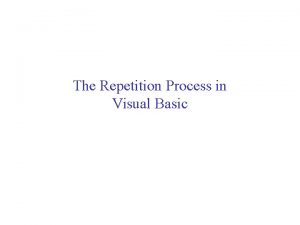CHAPTER 4 Repetition Structures Topics Introduction to Repetition













![Simple Loop With List of Strings for name in ['Winken', 'Blinken', 'Nod']: print(name) Output Simple Loop With List of Strings for name in ['Winken', 'Blinken', 'Nod']: print(name) Output](https://slidetodoc.com/presentation_image_h/2c6e462f2d52b98729531e9e0d24d146/image-14.jpg)










- Slides: 24

CHAPTER 4 Repetition Structures

Topics • Introduction to Repetition Structures • The while Loop: a Condition-Controlled Loop • The for Loop: a Count-Controlled Loop • Calculating a Running Total

Introduction to Repetition Structures • Often have to write code that performs the same task multiple times • Disadvantages to duplicating code • Makes program large • Time consuming • May need to be corrected in many places • Repetition structure: makes computer repeat code • Includes condition-controlled loops and countcontrolled loops

The while Loop • while loop: while condition is true, do something • Two parts: • Condition tested (just like in If/else) • Set of Statements repeated as long as condition is true • General format: while condition: statements • Notice • Indentation like If statement. • while statement ends when indentation ends • ‘: ’ after condition

The while Loop Flow Control

The while Loop • In order for a loop to stop executing, something has to happen inside the loop to make the condition false • Iteration: one execution of the body of a loop • while loop is known as a pretest loop – Tests condition before performing an iteration • Will never execute if condition is false at start • Requires performing some steps prior to the loop


Commission Program # This program calculates sales commissions. keep_going = 'y' # Create a variable to control the loop. # Calculate a series of commissions. while keep_going == 'y': sales = float(input('Enter the amount of sales: ')) comm_rate = float(input('Enter the commission rate: ')) commission = sales * comm_rate # Calculate the commission. # Display the commission. print('The commission is $', format(commission, ', . 2 f'), sep='') # See if the user wants to do another one. keep_going = input('Do you want to calculate another ' + 'commission (Enter y for yes): ')

Infinite Loops • Loops must contain within themselves a way to terminate • Something inside a while loop must eventually make the condition false • Infinite loop: loop that does not have a way of stopping • Repeats until program is interrupted • Occurs when programmer does not set the loop condition to be false

The for Loop • Count-Controlled loop: performs loop a specific number of times • Use a for statement to write count-controlled loop • Designed to work with sequence of data items – Iterates once for each item in the sequence • General format: for variable in [val 1, val 2, etc]: statements • Target variable: the variable which is the target of the assignment at the beginning of each iteration


Simple Loop With List of Numbers print('I will display the numbers 1 through 5. ') for num in [1, 2, 3, 4, 5]: print(num) Output I will display the numbers 1 through 5. 1 2 3 4 5

Simple Loop With List of Odd Numbers print('I will display the odd numbers 1 through 9. ') for num in [1, 3, 5, 7, 9]: print(num) Output I will display the odd numbers 1 through 9. 1 3 5 7 9
![Simple Loop With List of Strings for name in Winken Blinken Nod printname Output Simple Loop With List of Strings for name in ['Winken', 'Blinken', 'Nod']: print(name) Output](https://slidetodoc.com/presentation_image_h/2c6e462f2d52b98729531e9e0d24d146/image-14.jpg)
Simple Loop With List of Strings for name in ['Winken', 'Blinken', 'Nod']: print(name) Output Winken Blinken Nod

Using range Function in for Loop • Simplifies the process of writing a for loop • range returns an iterable object • Iterable: contains a sequence of values that can be iterated over for num in range (arg 1, [arg 2, [arg 3]]) statements • range characteristics: • One argument: used as ending limit • Two arguments: starting value and ending limit • Three arguments: third argument is step value

Range Example for num in range (5): print(num) Output 0 1 2 3 4 Same as for num in [0, 1, 2, 3, 4]: print(num)

Range Examples for num in range (1, 5): print(num) Output 1 2 3 4 for num in range (1, 10, 2): print(num) Output 1 3 5 7 9

Using Target Variable Inside Loop • Purpose of target variable is to reference each item in a sequence as the loop iterates • Target variable can be used in calculations or tasks in the body of the loop • Example: calculate square root of each number in a range • Ending value will not be included in loop since that is when loop stops

Speed Converter Example start_speed = 60 # Starting speed end_speed = 131 # Ending speed increment = 10 # Speed increment conversion_factor = 0. 6214 # Km/hr to MPH conversion factor # Print the table headings. print('KPHt. MPH') print('-------') # Print the speeds. for kph in range(start_speed, end_speed, increment): mph = kph * conversion_factor print(kph, 't', format(mph, '. 1 f'))

Speed Converter Output KPH MPH -------60 37. 3 70 43. 5 80 49. 7 90 55. 9 100 62. 1 110 68. 4 120 74. 6 130 80. 8

Letting User Control Loop Iterations • Sometimes the programmer does not know exactly how many times the loop will execute • Can receive range inputs from the user, place them in variables, and call range function in for clause using these variables • Be sure to consider the end cases: range does not include the ending limit

Find Squares Example # Get the ending limit. print('This program displays a list of numbers') print('(starting at 1) and their squares. ') end = int(input('How high should I go? ')) # Print the table headings. print() print('Numbert. Square') print('-------') # Print the numbers and their squares. for number in range(1, end + 1): # Add 1 since loop stops at end square = number**2 print(number, 't', square)

Find Squares Output This program displays a list of numbers (starting at 1) and their squares. How high should I go? 5 Number Square ---------1 1 2 4 3 9 4 16 5 25

Generating an Iterable Sequence that Ranges from Highest to Lowest • The range function can be used to generate a sequence with numbers in descending order • Make sure starting number is larger than end limit, and step value is negative • Example: range (10, 0, -1)
 Give other examples of homologous structures
Give other examples of homologous structures Repetition structures
Repetition structures Emotional words propaganda meaning
Emotional words propaganda meaning Introduction to data structures
Introduction to data structures Introduction to data structures
Introduction to data structures Chapter 9 topics in analytic geometry
Chapter 9 topics in analytic geometry Chapter 7 organizational structures
Chapter 7 organizational structures Chapter 7 lesson 1 competition and market structures
Chapter 7 lesson 1 competition and market structures Chapter 7 section 3 structures and organelles
Chapter 7 section 3 structures and organelles Knee anatomy chapter 16 worksheet 1
Knee anatomy chapter 16 worksheet 1 Chapter 16 worksheet the knee and related structures
Chapter 16 worksheet the knee and related structures Chapter 7 organizational structures
Chapter 7 organizational structures Data structures chapter 1
Data structures chapter 1 Chapter 7 market structures vocabulary
Chapter 7 market structures vocabulary Hello
Hello Chapter 7 section 3 structures and organelles
Chapter 7 section 3 structures and organelles Foreshadowing in the great gatsby chapter 7
Foreshadowing in the great gatsby chapter 7 Great gatsby summary chapter 3
Great gatsby summary chapter 3 Introduction paragraph format
Introduction paragraph format School magazine article examples
School magazine article examples Persuasive essay grade 9
Persuasive essay grade 9 Thematic essay introduction example
Thematic essay introduction example Behavioural training topics
Behavioural training topics Skill 6 listen for who and what with multiple nouns
Skill 6 listen for who and what with multiple nouns What is competency based interview
What is competency based interview

